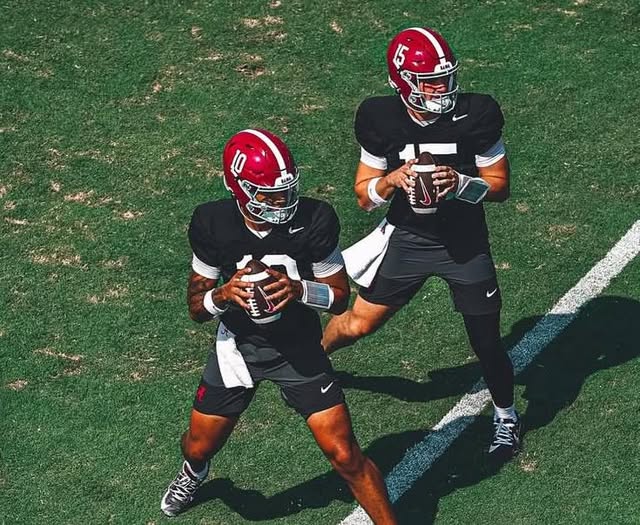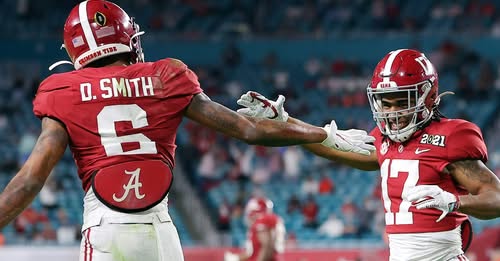The Sooners have improved since their most recent encounter with the Crimson Tide.
Before we delve into the improvements made by the Sooners, it’s essential to first understand the context of their most recent game against Alabama. In a meeting that took place in the College Football Playoff (CFP), the two teams faced off in what was expected to be a highly competitive battle, given their respective histories and talent pools. However, the game revealed clear disparities in terms of both team execution and talent.
Alabama entered the contest as one of the most dominant teams in college football, with a roster brimming with NFL-caliber talent on both sides of the ball. Quarterback Tua Tagovailoa, along with a formidable offensive line and skilled defensive players like Quinnen Williams and Jerry Jeudy, made Alabama a daunting opponent. The Crimson Tide had a reputation for overpowering teams with their relentless defense, explosive offense, and overall depth.
On the other hand, Oklahoma, while talented, was still somewhat of a work in progress. The Sooners had a high-powered offense, led by quarterback Kyler Murray and a dynamic group of skill players, but their defense was often criticized for being inconsistent and porous. In that game, Alabama’s physicality and depth were evident, with the Crimson Tide dominating both sides of the ball. The Sooners were unable to match up, particularly in the trenches, where Alabama’s superior line play allowed them to control the pace of the game.
Despite the loss, Oklahoma showed flashes of brilliance, particularly on offense, which kept the game competitive at times. However, the result underscored the need for improvement, especially in areas where Alabama excelled, such as defensive line play, pass protection, and the ability to stop the run.
One of the first and most significant changes since that encounter has been the evolution of the Oklahoma coaching staff. While Lincoln Riley has been at the helm for several years, his tenure has been marked by growth and development, particularly in the areas of game management and player development. However, after that loss to Alabama, Riley seemed to recognize the need to shore up the defensive side of the ball.
In response to the criticisms surrounding Oklahoma’s defense, Riley made several key moves to bolster the coaching staff. One of the most notable hires was the recruitment of veteran defensive coordinator Alex Grinch. Grinch, known for his aggressive and high-energy defensive schemes, was tasked with transforming Oklahoma’s defense, which had often been seen as a liability. His arrival signaled a commitment to improving one of the Sooners’ most glaring weaknesses.
Under Grinch’s guidance, the Oklahoma defense has undergone a complete overhaul. Grinch’s aggressive, fast-paced approach to defense, which emphasizes forcing turnovers and creating disruption, has been a marked departure from the more passive style of previous years. The results have been promising. In subsequent seasons, the Sooners’ defense has shown significant improvement, becoming more disciplined, better at stopping the run, and more opportunistic in creating turnovers. Grinch’s emphasis on improving defensive line play, linebacker development, and secondary coverage has made a noticeable difference in how the Sooners compete against high-powered offenses.
In addition to coaching changes, the Oklahoma Sooners have made significant strides in player development and recruiting. While Alabama has long been known for its ability to recruit elite talent year in and year out, Oklahoma has followed suit in recent years by securing some of the top high school recruits in the country.
Since their loss to Alabama, the Sooners have significantly upgraded their roster, particularly in areas that were exposed during that game. The most notable improvement has come in the trenches, where Oklahoma’s offensive and defensive lines have been strengthened. The Sooners have recruited highly rated offensive linemen who have contributed immediately, providing much-needed protection for the quarterback and creating more room in the running game. On defense, the Sooners have added talented defensive linemen and linebackers who have been able to disrupt opposing offenses, forcing them to play at a faster pace and making it more difficult for them to establish a rhythm.
Quarterback play has also remained a strength for Oklahoma. Kyler Murray, who was already one of the best quarterbacks in college football at the time of their matchup with Alabama, has since been replaced by Spencer Rattler, a highly touted recruit. While Rattler’s early years at Oklahoma were marked by growing pains, he showed flashes of greatness and took major strides in his development, solidifying the Sooners’ offense as a top-tier unit in the nation.
The Sooners have also made significant improvements in their secondary. A year after their encounter with Alabama, Oklahoma focused heavily on recruiting cornerbacks and safeties who could compete at the highest levels. This shift has paid off, as Oklahoma’s defense is now better equipped to cover elite wide receivers, something that was a struggle in previous seasons.
Oklahoma’s offensive system has also evolved since their meeting with Alabama. Lincoln Riley’s offense, while always potent, has adapted in response to the growing talent pool and the increasing importance of balance in a competitive college football landscape. Riley, a former offensive coordinator, is known for his innovative playcalling and ability to get the most out of his quarterbacks. Since the loss to Alabama, Riley has incorporated more diverse elements into his offensive system, particularly in the areas of run-pass options (RPOs), motion, and pre-snap movement to create mismatches.
While the Sooners’ offense was already a force to be reckoned with, the adjustments have allowed them to maintain their explosive nature while also adding more versatility. Riley’s ability to adapt to different defensive schemes has made Oklahoma’s offense even more difficult to defend. This flexibility ensures that Oklahoma is prepared to face any challenge, whether it’s a high-powered offense or a stout defense like the one Alabama fields.
Additionally, Riley has focused on improving the balance between the run and pass game, ensuring that his offense is not one-dimensional. The Sooners have developed a more consistent ground attack, which has allowed them to control the clock and keep opposing defenses off balance. The combination of a strong passing game, a power running attack, and the ability to adapt to defensive schemes has made Oklahoma’s offense even more formidable since their matchup with Alabama.
Since their loss to Alabama, Oklahoma has positioned itself as a serious contender for a national title. The combination of improved defense, continued offensive excellence, and the development of a deeper, more talented roster has put Oklahoma on par with the elite teams in college football. While Alabama still stands as one of the most dominant programs, Oklahoma has closed the gap significantly, and with each passing season, the Sooners are more equipped to compete against teams like Alabama at the highest levels.
Oklahoma’s continued success in recruiting, player development, and coaching adjustments has ensured that they are a program capable of challenging for the College Football Playoff year after year. With Lincoln Riley’s leadership, the defensive improvements under Alex Grinch, and the growth of their talent, the Sooners are not only competitive but poised to make a deeper run in the CFP
The Oklahoma Sooners have made significant strides since their most recent encounter with the Alabama Crimson Tide. Through coaching changes, recruiting success, player development, and tactical adjustments, the Sooners have transformed themselves into a more balanced and well-rounded team. While Alabama remains a powerhouse, Oklahoma is no longer a distant second; they are now a program capable of competing with the best of the best in college football.
As they look ahead to future matchups against top-tier teams like Alabama, the Sooners will be much better equipped to challenge for a national title. With continued growth and improvement, the Oklahoma Sooners are a team to watch in the coming seasons, and their trajectory suggests that they could be on the verge of breaking through to the next level in college football.



